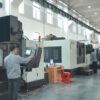The rise and development of 3D printing technology are inseparable from the development of 3D printing materials. There are various 3D printing technologies, such as SLS, SLA, and FDM. The printing materials of each printing technology are different. For example, the commonly used printing material for SLM is metal powder. In contrast, SLA usually uses photosensitive resin, and FDM uses a wide range of materials, such as ABS plastic and PLA plastic.
At present, there are more than 200 kinds of 3D printing materials. From the perspective of direct digital manufacturing, more than 200 materials are still minimal because there are many products in reality, and the production materials and their combinations are also complicated. Currently, the more popular 3D printing consumables include PLA plastic, ABS plastic, nylon aluminum powder material, artificial rubber, casting wax, polyester thermoplastic, metal powder, ceramic powder, gypsum powder, etc. Among them, ABS plastic is a thermoplastic engineering plastic with many uses. Artificial rubber, metal powder, etc., also have thermoplastic properties, an essential requirement for 3D printing consumables. Some car parts are printed with such consumables.
Introduction to common 3D printing materials
- ABS plastic
ABS is the most commonly used printing material for FDM. At present, there are many colors to choose from. It is the favorite printing material for consumer-grade 3D printer users, such as printing many “Lego” type toys and making many creative home accessories. ABS materials are usually filament coils, heated and melted through a 3D printing nozzle. Since the nozzle needs to be solidified immediately after spraying, the heating temperature of the nozzle is controlled to be 1 to 2 °C higher than the thermal melting point of the ABS material. Different ABS cannot be used for nozzles that cannot adjust the temperature due to other melting points. It is best to buy printing materials from the original manufacturer.
- PLA plastic
PLA plastic fuse is also a ubiquitous printing material. Especially for consumer 3D printers, PLA can be degraded and is an environmentally friendly material. PLA generally does not require a heated bed, unlike ABS, so PLA is easy to use and more suitable for low-end 3D printers. PLA is available in various colors and translucent red, blue, green, and fully transparent materials. The versatility of PLA also needs to be improved.
- Acrylic materials
Acrylic refers to a PMMA plate made of the organic compound methyl methacrylate monomer (Methyl Methacrylate, MMA), and its transparency and light transmittance are like glass. All sheets of transparent plastics (such as PS, PC, etc.) or low-quality recycled MMA are collectively called plexiglass. Acrylic (plexiglass) material has a good surface finish and can print transparent and translucent products. It is possible to print out tooth models for orthodontic treatment using acrylic material.
- Nylon aluminum powder material (Alumide)
Nylon aluminum powder is a part of aluminum powder mixed with nylon powder, which is printed by SLS technology so that the printed product has a metallic luster. When the content of aluminum powder increased from 0 to 50%, the heat distortion temperature of the finished product increased by 87 °C, the tensile strength increased by 10.4%, the bending power increased by 62.1%, the flexural modulus increased by 122.3%, and the hardness increased by 10.4%. It is 70.4% higher than that of pure nylon sintered parts. In addition, the tensile strength, elongation at break, and impact strength of the sintered parts also increased with the decrease of the average particle size of the aluminum powder. This material is often used to print creative products for decorations and jewelry.
- Ceramic powder
The ceramic powder was sintered using SLS. Glazed ceramic products can hold food, and many people use ceramics to print personalized cups. Of course, 3D printing cannot complete the high-temperature firing of ceramics, and high-temperature firing is required after printing is completed.
- Resin material
Resin usually refers to an organic polymer that softens or melts after being heated, tends to flow under the action of external force when softened, and is solid, semi-solid, or sometimes liquid at room temperature. Generally insoluble in water, soluble in organic solvents. Resins can be divided into natural and synthetic resins according to their sources; they are divided into thermoplastic resins and thermosetting resins according to their processing behavior. Resin is an important raw material for SLA light curing molding. There are many changes, including transparent and semi-solid, which can be used to make intermediate design process models. Since its molding accuracy is higher than that of FDM, it can be used as a biological or medical model.
- Stainless Steel
Stainless steel is increasingly popular because of its beautiful appearance, corrosion resistance, and not ease of damage. More and more stainless steel is used in daily necessities, urban sculptures, architecture, and the decoration of bedrooms. Stainless steel is complex and has a firm firmness. The stainless steel powder is 3D sintered using SLM technology and is available in silver, bronze, and white. Stainless steel can make models, modern art, and many functional and decorative items.
- Color Printing Materials
There are two cases of color printing. One is that two or more colors of the same or different materials are extruded from their respective nozzles. The most commonly used is a consumer-grade FDM dual-nozzle printer through two or more materials. Combinations to form limited color combinations. The other is to use the principle of inkjet printers through the combination of different dyes mixed with binders and injected into the printing material powder for solidification. In theory, this technology can print “true color” 3D objects. The printing material usually chooses resin, polypropylene, or ABS.







